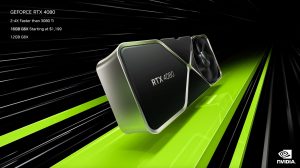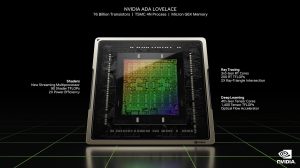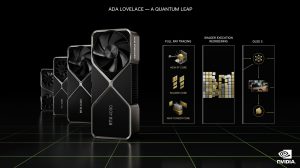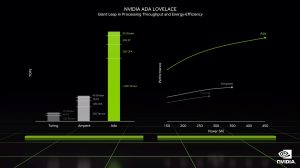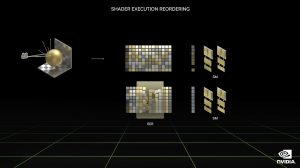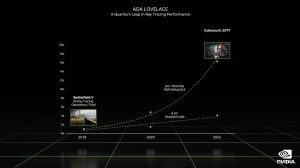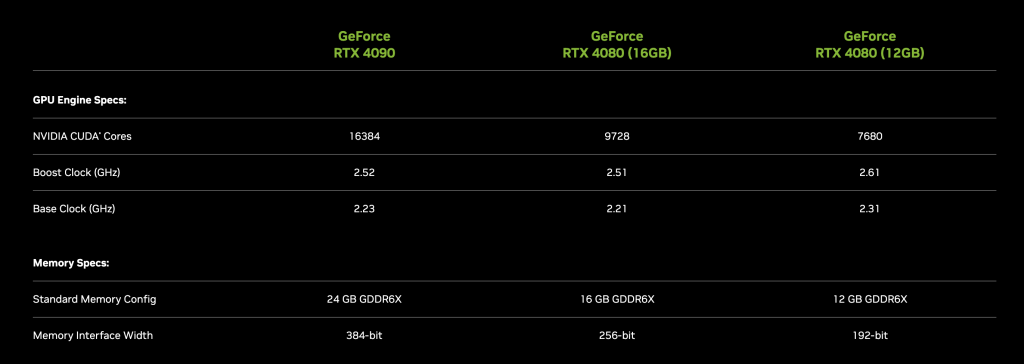Today during a GeForce Special Event stream, Nvidia CEO, Jensen Huang, officially announced the RTX 4090 and RTX 4080 graphics cards. Powered by the new Ada Lovelace architecture, featuring 3rd Gen RT Cores, 4th Gen Tensor Cores, and plenty of new optimisations to enable next-generation performance.
The RTX 40 series will be based on the TSMC 4N process node, with up to 76 billion transistors. This new architecture introduces several new optimisations to enable higher performance across games. Ray-tracing will be further boosted by a new feature, Shader Execution Reordering (SER), which reschedules shading workloads on the fly to better utilise the GPUs. Nvidia claims SER can offer a 3x improvement for shader performance in ray traced workloads, as well as a 25% boost for ‘in-game frame rates', likely referring to rasterisation performance.
The new architecture also paves the way for DLSS 3. The latest version of DLSS can predict how the scene is supposed to change and then generate entirely new frames for the image. This enables even bigger performance gains for both CPU-bound and GPU-bound titles. In an example, Nvidia shows Cyberpunk 2077 running on an RTX 4090 with a new ‘maximum ray-tracing' graphics mode. Without DLSS 3, the GPU manages around 22 frames per second, but that number boosts up to 100 FPS once DLSS 3 is switched on.
Ada has introduced the new 8th-gen NVIDIA Encoder (NVENC), this time offering AV1 encoding. This technically launched first on the Intel ARC A380, but will now hit an even wider market. Nvidia reckons the new AVI encoder is ‘40% more efficient than H.264', while gamers streaming at 1080p are supposedly able to ‘increase their stream resolution to 1440p while running at the same bitrate and quality.'
In terms of specs, the new Ada GPUs offer up to 76 billion transistors, with core count hitting over 16000 CUDA cores for the RTX 4090. Despite featuring the same name, the RTX 4080 SKUs have significantly different core counts, with 2048 fewer CUDA cores on the 12GB model. Boost clocks are significantly raised over the 30-series, with the RTX 4090 rated at 2.52GHz, while the RTX 4080 16GB hits 2.51GHz, a touch below the 2.61GHz clock of the 12GB model.
All three SKUs feature GDDR6X memory, with varying capacities, but the RTX 4090 has a 384-bit memory interface, compared to 256-bit and 192-bit for the RTX 4080 16GB and RTX 4080 12GB, respectively. Power draw is also confirmed, with a 450W Graphics Card Power rating for the RTX 4090, 320W for the RTX 4080 16GB and 285W for the RTX 4080 12GB.
The RTX 4090 will be the first to launch, promising up to 4x more performance than an RTX 3090 Ti for $1599 (£1,679 in the UK). This graphics card will become available on the 12th of October. After that, we'll see two versions of the RTX 4080 launch, promising up to 4x more performance than the 3080 Ti. The 16GB version of the RTX 4080 will launch at $1199 (£1,269), and the 12GB version will launch at $899 (£949).
The RTX 3080, RTX 3070 and RTX 3060 graphics cards will continue to be sold alongside RTX 4090 and RTX 4080. Prices for Nvidia's previous generation GPUs will start at $329.
Discuss on our Facebook page HERE.
KitGuru Says: The Lovelace architecture brings along some promising improvements, and DLSS 3 looks particularly impressive. However, we are facing increased gen-on-gen prices. What did you all think of Nvidia's reveal today?
 KitGuru KitGuru.net – Tech News | Hardware News | Hardware Reviews | IOS | Mobile | Gaming | Graphics Cards
KitGuru KitGuru.net – Tech News | Hardware News | Hardware Reviews | IOS | Mobile | Gaming | Graphics Cards


